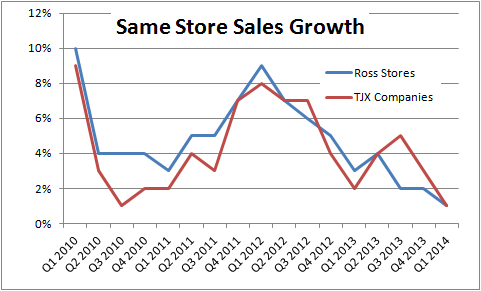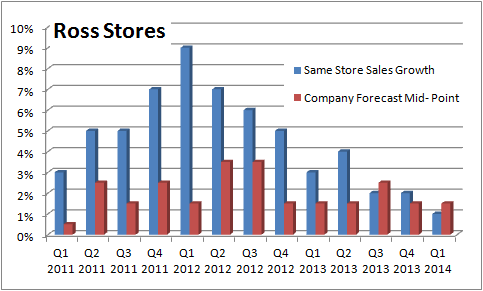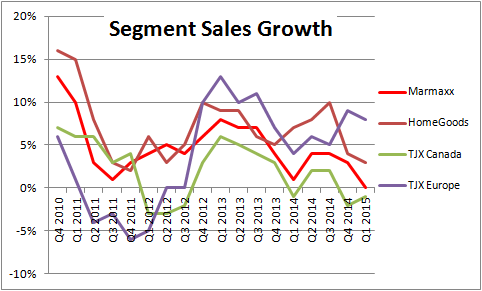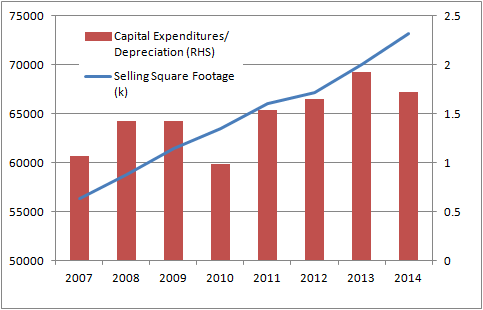It's been a difficult couple of quarters for off-price retailers like TJX (TJX 0.99%) and Ross Stores (ROST 0.61%) with a combination of extreme bad weather and a tough retail environment causing sluggish sales growth. The question going forward is whether this is just a temporary, weather-related phenomenon or the start of a downtrend.
TJX and Ross Stores report
Ross Stores and TJX have both reported and given disappointing sales growth figures. A chart of their comparable same-store sales figures (adjusted to fit the calendar year) demonstrates that they tend to follow each other and that the last two quarters have been difficult.

Source: TJX Companies and Ross Stores Presentation
Both companies' same stores sales figures came in at 1%, while they had both forecast 1%-2% growth for the quarter. This is particularly disappointing because the market has come to expect them to beat their usually conservative guidance. A quick look at Ross Stores' history of same-store sales growth versus guidance reveals this dynamic in process.

Source: Ross Stores Presentations
The slowing growth is clearly a concern, particularly as both companies are undergoing expansion strategies. Will it prove temporary?
Whether the weather?
There is no doubt that the extreme bad weather -- which straddled the two reporting quarters for both companies -- had a significant effect on their results. But Ross Stores seemed to cope with the conditions a bit better than TJX. Ross Stores' management cited the weather in their results statement, but they actually increased the bottom end of full-year earnings-per-share guidance by $0.04 to a range of $4.09-$4.21 TJX, meanwhile, was forced to reduce the top end of its full-year guidance by $0.02 to between $3.05 and $3.17.
Focusing on TJX, there were a few notable takeaways which should extend confidence to investors.
First, its EPS came in at $0.64, slightly below the bottom end of its previous $0.65-$0.66 guidance; but its earlier estimate had assumed a $0.01 hit from foreign exchange, when the actual hit came in at $0.02
Second, according to TJX's management on the conference call, there was a 4% difference in growth between sales in its weather-affected regions and the less affected areas for its core Marmaxx sales. Moreover, even though management cited some execution issues with the junior and dress categories, the effect was small compared to the weather-related impact.
According to CFO Scott Goldenberg on the conference call,
If you ever did, I guess dollar it out to figure out the impact that would be far greater than junior dress business execution impact.
And TJX's CEO Carol Meyrowitz argued that sales would have been at the high end of the company's range had it not been for the weather.
Third, TJX's guidance for the second quarter was for 2%-3% same-store sales growth -- an unusually strong number for a company that tends to guide toward 1%-2%. Fourth, a breakout of its segment sales demonstrates that its European operations are growing well.

Source: TJX Presentations
Although, Europe only contributed 4.8% of segmental profit in the quarter, there is substantial scope for TJX to increase its profitability in the region in future. For example, Marmaxx generates mid-teens margins for TJX in the U.S. while TJX's segmental margins in Europe were only 4.3% in the first quarter. TJX is in the early stages of expanding in Europe and the expectation is that it can aggressively increase revenue and margins in future.
Why both stocks remain a good value
If investors believe that the weakness over the last two quarters is temporary, then both stocks provide compelling value. Again, I will focus on TJX.
It's always useful to think of how much underlying cash flow a company is actually generating. One way to do it -- particularly with a company engaging in aggressive expansion -- is to take its depreciation rate as a proxy for maintenance capital expenditures.
Here is a chart demonstrating how TJX has consistently spent more on capital expenditures than depreciation in order to expand its selling square footage.A ratio above one implies that a company is in an expansion phase, while below one implies it is consolidating.

Source: TJX Companies Presentations
Therefore, looking at last year's figures, TJX generated $2.6 billion in operating cash flow and its capital expenditures came to $947 million. This means that free cash flow was approximately $1.6 billion. However, if you assume that the underlying capital expenditures equate to depreciation of $549 million, then the underlying free cash flow figure is $2 billion, or 5.3% of the company's current enterprise value.
A similar calculation for Ross Stores would mean its underlying free cash flow last year was equivalent to 5.9% of its enterprise value.
The bottom line
All told, TJX and Ross Stores probably suffered inordinately from poor weather in the last two quarters, and the early indications are that the current quarter will be better for them. It's quite possible that better weather will encourage the retail industry to promote rather less aggressively than it had to over the winter months.
Neither stock is particularly expensive on an underlying free cash flow basis, and they both have the opportunity to bounce back from recent weakness.